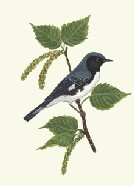Christmas Bird Count 2013
December 19th
Click HERE for further information
More than 50,000 observers participate each year in this all-day census of early-winter bird populations. The results of their efforts are compiled into the longest running database in ornithology, representing over a century of unbroken data on trends of early-winter bird populations across the Americas. Simply put, the Christmas Bird Count is citizen science in action.
Prior to the 1900s, people engaged in a holiday traditions know as the Christmas “Side Hunt.” They would choose sides and go afield with their guns; whoever brought in the biggest pile of feathered (and furred) quarry won. Conservation was in its beginning stages around the turn of the 20th century, and many observers and scientists were becoming concerned about declining bird populations. Beginning on Christmas Day 1900, ornithologist Frank Chapman, an early officer in the then budding Audubon Society, proposed a new holiday tradition—a “Christmas Bird Census”—that would count birds in the holidays rather than hunt them.
So began the Christmas Bird Count. Thanks to the inspiration of Mr. Chapman and the enthusiasm of twenty-seven dedicated birders, twenty-five Christmas Bird Counts were held that day. The locations ranged from Toronto, Ontario, to Pacific Grove, California, with most counts in or near the population centers of northeastern North America. Those original 27 Christmas Bird Counters tallied a combined total of 90 species.
The primary objective of the Christmas Bird Count is to monitor the status and distribution of bird populations across the Western Hemisphere.
The count period, which is from December 14th to January 5th, in North America is referred to as "early winter," because many birds at this time are still in the late stages of their southward migration, so it is not "true" winter. When we combine these data with other surveys such as the Breeding Bird Survey, we begin to see a clearer picture of how the continent's bird populations have changed in time and space over the past hundred years.
The information is also vital for conservation. For example, local trends in bird populations can indicate habitat fragmentation or signal an immediate environmental threat, such as groundwater contamination or poisoning from improper use of pesticides.
From feeder-watchers and field observers to count compilers and regional editors, everyone who takes part in the Christmas Bird Count does it for love of birds and the excitement of friendly competition -- and with the knowledge that their efforts are making a difference for science and bird conservation.
As long as there are birds to be counted, the Christmas Bird Count will go on being the most popular, fun, and rewarding bird census the world over!
Text thanks to The National Audubon Society
The mission of the Highlands Plateau Audubon Society is to provide opportunities to enjoy and learn about birds and other wildlife and to promote conservation and restoration of the habitats that support them.
Serving Highlands, Cashiers, Franklin
and Scaly Mountain
in Western North Carolina
Serving Highlands, Cashiers, Franklin
and Scaly Mountain
in Western North Carolina
Serving Highlands, Cashiers, Franklin
and Scaly Mountain
in Western North Carolina



